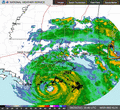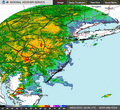Hurricane Ida facts for kids
| Category 2 hurricane (SSHWS/NWS) | |

Hurricane Ida near peak intensity on November 8
|
|
| Formed | November 4, 2009 |
|---|---|
| Dissipated | November 10, 2009 |
| Highest winds | 1-minute sustained: 105 mph (165 km/h) |
| Lowest pressure | 975 mbar (hPa); 28.79 inHg |
| Fatalities | 1 direct |
| Damage | $5.6 million (2009 USD) |
| Areas affected | Nicaragua, Honduras, El Salvador, western Cuba, Yucatan Peninsula, Louisiana, Mississippi, Alabama, Florida Panhandle, Georgia |
| Part of the 2009 Atlantic hurricane season | |
Hurricane Ida was the last big storm of the 2009 Atlantic hurricane season. It started forming in the southwestern Caribbean on November 4, 2009. After it became a tropical depression, it quickly grew stronger. It turned into a tropical storm and then a hurricane just before it hit Nicaragua.
As Hurricane Ida moved over Central America, it lost a lot of its power very quickly. It was downgraded to a tropical depression by the end of November 5. By November 6, Ida moved back over the Caribbean Sea and became a hurricane again. Its strength changed a few more times before it finally ended on November 10, near the coast of Alabama. Hurricane Ida caused about $5.6 million in damage and led to one death.
Contents
How Hurricane Ida Formed and Moved
Hurricane Ida began as a tropical wave that entered the western Caribbean Sea on November 1. A low pressure area soon formed near this wave. This low pressure area didn't move much, and many clouds gathered around its center. There was very little wind shear, which helped more clouds to form and grow.
Ida Becomes a Tropical Storm
On November 4, the National Hurricane Center started calling this system Tropical Depression Eleven. This new tropical depression quickly got stronger and became Tropical Storm Ida soon after. An aircraft flew into Ida and found winds blowing at 65 miles per hour. This meant it was almost strong enough to be a hurricane.
Ida Reaches Hurricane Strength
As it continued moving northwest, Tropical Storm Ida became Hurricane Ida. Its winds reached 80 miles per hour. Soon after this, Hurricane Ida made landfall in Nicaragua on November 5. When it moved over land, Ida quickly weakened. It was downgraded to a tropical storm right after landfall. By the end of November 5, Tropical Storm Ida had weakened even more, becoming a tropical depression.
Ida Regains Strength Over Water
Tropical Depression Ida managed to survive its journey over land. It moved back into the Caribbean Sea on November 6. Over the western Caribbean, it quickly became a tropical storm again. After moving north, Tropical Storm Ida turned into a hurricane once more.
Ida reached its strongest winds on November 8. At this time, it was moving between Cuba and Mexico. Its winds were measured at 105 miles per hour, making it a Category 2 hurricane. However, the water in the Gulf of Mexico was not warm enough to keep Ida this strong. So, it quickly weakened back into a tropical storm.
For only six hours, it became a hurricane one last time. Then, it changed into an extratropical storm on November 10. This happened when it was just south of Alabama. At first, people thought it had stayed a tropical storm and made landfall in Alabama, but this was later found to be incorrect. The leftover parts of Ida then formed a strong nor'easter storm. This nor'easter affected some states along the East Coast of the United States.
What Happened Because of Ida
Damage in Nicaragua was about $2.1 million. Luckily, no one was killed there. In El Salvador, there were initial reports of many deaths, but this was later found to be a mistake.
Related pages
- 2008 Athurricane.org
|
Tropical cyclones of the 2009 Atlantic hurricane season |
|||||||||||||||||||||||||||
|
|
|
||||||||||||||||||||||||||
|
|
|||||||||||||||||||||||||||
Images for kids
-
Hurricane Ida rapidly intensifying in the Gulf of Mexico on August 28 viewed from the ISS
-
Ida as an extratropical cyclone over the Northeastern United States
-
Hurricane Ida over western Cuba late on August 27
-
Hurricane Ida at landfall in Port Fourchon, Louisiana, on August 29; an outer eyewall can be seen surrounding the inner eyewall.
-
Flooding in Conshohocken, Pennsylvania on September 2, 2021
-
Damage from an EF2 tornado spawned by Ida in Upper Dublin Township, Pennsylvania.
-
Long Island Expressway in New York City shut down due to flooding from the remnants of Hurricane Ida.
-
U.S. President Joe Biden meets with residents of LaPlace, Louisiana on September 3
-
The remnants of Hurricane Ida inundated many of New York's subway tunnels, shutting down much of the MTA system.
-
Bethesda Terrace after the flooding had mostly receded
See also
 In Spanish: Huracán Ida para niños
In Spanish: Huracán Ida para niños















